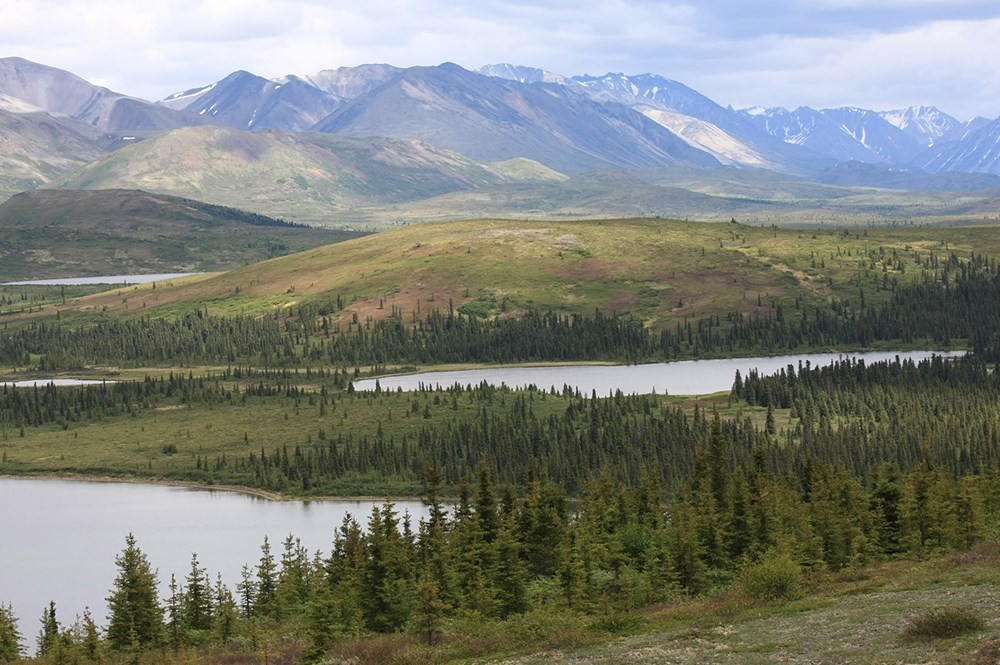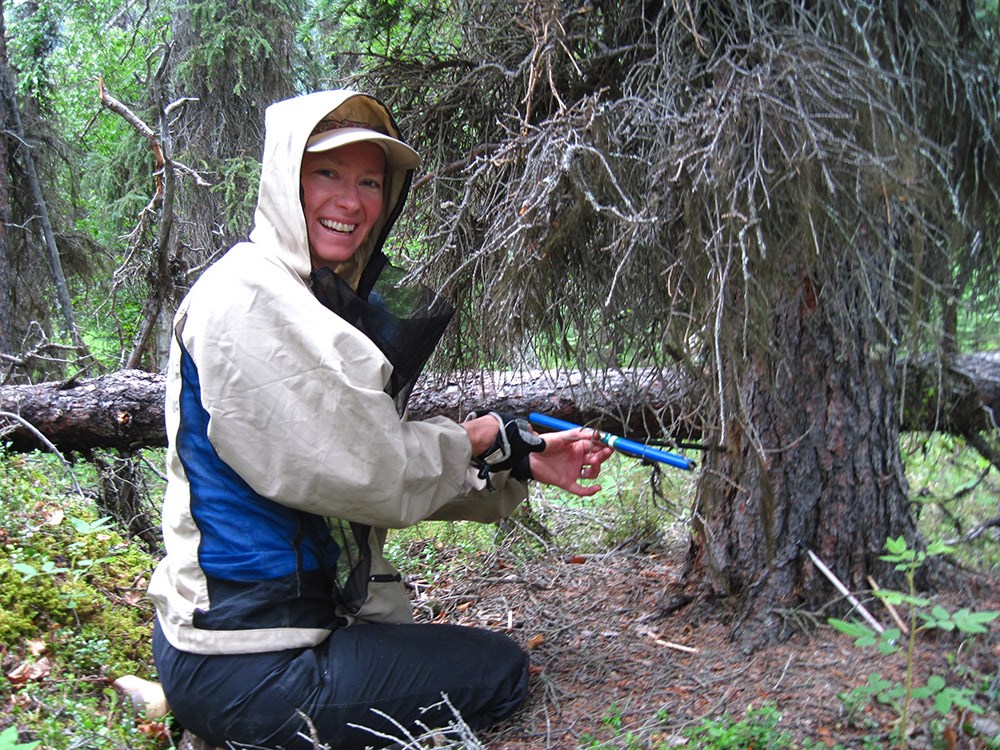Last updated: July 25, 2025
Article
Spruce Growth in Southwest Alaska

Spruce Trees, Warming Temperatures, and Water Availability
Spruce trees in southwest Alaska historically grew faster in warmer years, but this pattern has broken down in the recent decades. This pattern change, called divergence by some scientists, has been documented in many Arctic and boreal forests. One common explanation is that as temperatures warm, trees need more water. If trees are too thirsty (drought stressed), they're unable to increase growth in warmer years.
This study combined tree ring analysis and stable isotope analysis—a technique that analyzes the proportions of an element with varied characteristics (numbers of protons) in organisms. Each year that a tree grows, its trunk expands and creates a distinct growth ring. These rings can be counted and measured to assess how much the tree grew each year. As the tree photosynthesizes and grows, it preferentially uses a certain form, or isotope, of carbon. When water is scarce, trees are less choosy about which form of carbon they use. With this knowledge, scientists can compare the ratio of different carbon isotopes in a tree's wood to get clues about its drought stress. By measuring the ratio of carbon isotopes in each growth ring, scientists created year-by-year histories of drought stress and tree growth.
Growth Patterns Found in Tree Rings
After performing analyses on samples from trees across sites in and near Lake Clark and Katmai national parks and preserves, scientists detected several patterns:- Tree growth initially increased in both dense and sparse forest stands from 1970 to 1990. However, this trend shifted in the latter half of the study period (1991–2011), with dense forest growth leveling off while sparse forest growth maintaining a slight increase.
- Prior to 1990, warmer spring temperatures positively influenced growth in both forest types, but warmer summer temperatures had a negative impact on forests. Again, these patterns did not persist in the latter half of the study.
Based on isotope ratios, there was no sign of increasing drought stress over the decades, nor was there consistent, strong responses across sites in a given year. Isotope ratios were related to summer precipitation in dense forests, suggesting that water availability may intermittently limit growth.

The Bigger Picture
The findings from this study matter because many of the forested sites have also been severely damaged by spruce beetle outbreaks. A previous study from Lake Clark and Katmai showed that trees killed by the spruce beetle had shown growth declines prior to death and some may have been drought stressed, weakening their defenses against the beetle (Csank et al. 2016). This recent study expanded on this work by comparing indicators of water stress in crowded forest stands and open woodlands during a recent period of warming (1970-2011) to determine whether trees across the broader landscape might be susceptible to drought. It found that woodlands, which comprise most of the spruce-covered area in the parks, have shown measurable growth in response to warming and no sign of water limitation—in other words, they appear quite healthy. In contrast, growth in more dense forest stands began to level off in the 1980s and has not increased with warmer temperatures. Although forest sites showed signs of intermittent drought stress, the weakening relationship between temperature and growth, landscape-wide, appears to be only partially explained by water limitation.This work was conducted by scientists with the Southwest Alaska Network of the National Park Service Inventory & Monitoring Division; the University of Nevada, Reno; and California State Polytechnic University, Humboldt. The study highlights the need for further research across diverse environments to better understand the factors influencing forest growth and carbon uptake in the face of ongoing climate change.
Decoupling of temperature and growth of white spruce at western treeline, Alaska, is unrelated to intrinsic water stress
Abstract
Late 20th century warming has weakened the relationship between temperature and growth in northern forests. This loss of sensitivity to temperature, often attributed to drought stress in warmer regions of the boreal forest, has also been observed in cool, mesic environments, where warming-related growth declines are poorly understood. We used annually resolved ring-width and carbon stable isotope (δ13C) chronologies from white spruce forest and woodland stands in southwest Alaska to examine tree responses to climate during a recent warming period (1970–2011). Trends in ring-width index (RWI) varied by stand type: RWI increased in forests and woodlands in the first half of the record (1970–1990), but only woodlands continued that trend in the latter half (1991–2011). Warmer spring temperatures predicted increased RWI in both stand types, and warmer summer temperatures predicted decreased RWI in forests, but these relationships weakened through time. Carbon isotope discrimination (Δ13C), a frequent indicator of stomatal regulation of water loss, showed no coherent trend in either stand type but was positively associated with summer precipitation in forests, suggesting the potential for intermittent water limitation. Our results indicate that RWI and Δ13C have responded differently to climate through time and that these responses have been mediated by stand type.
Miller, A. E., A. Z. Csank, M. P. Hannam, R. L. Sherriff, and S. W. Leavitt. 2025. Decoupling of temperature and growth of white spruce at western treeline, Alaska, is unrelated to intrinsic water stress. Ecology 106: e70147.
